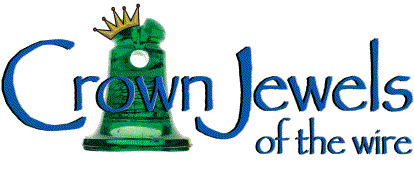Postal Memories
By N. R. Woodward
Reprinted from "Crown Jewels of the Wire", May 2003, page 5
(N.R. Woodward is the creator of the CD number classification system for
insulators. He responded to the Postal beehive article in the April issue of
CJOW and is providing some great information that we thought we'd share.)
Dear Howard,
Received the April CJ, a very good job! Despite the daunting nature of the
assignment, I feel that you are going to be entirely successful.
Now (as if you
don't have anything else of think about) just a few comments on POSTAL.
Interesting about the early years, I was not aware of the company's beginnings.
It is true that Postal never reached as many towns as Western Union: however in
later years they often leased a pair of wires from a railway to reach smaller
cities.
It isn't quite correct that Postal "went bankrupt". Postal
Telegraph and Cable Company was purchased by Western Union October 7, 1943.
Evidently the fight for survival during the War was more than they wanted to
attempt. Thus, that was the last competitor; Western Union was "it"
from then on. During the war years the Postal lines were generally ignored; I
remember rows of poles fallen over in some cases.
In 1947 I vividly recall a
Western Union work train on a siding in Salem, Oregon where I was living at the
time. They were demolishing the old Postal line in that area, along the Southern
Pacific right-of-way. In most cases in that area, the poles were not on railroad
property but rather on the other side of the right-of-way fence. In the country,
copper wire was salvaged, old No 8 iron wire was reeled into great rolls and
hidden in brush to rust away. Poles were cut down and left where they fell. In
town, things were, cleaned up better, I remember shattered purple glass
alongside Twelfth Street at the eastern edge of the Oregon Capitol Grounds
where the cross arms were dropped.
Five years later, when I had re-started
insulator collecting, Postal insulators were still abundant in rural areas. In
fact I made enemies by using Army leave time to hunt Postal lines for
insulators, instead of socializing with family.

The Postal line along the West Coast followed the Northern Pacific
right-of-way to Longview Jct., where it crossed the Columbia River in an
underwater cable and followed the east side of the Astoria Branch of the
Spokane, Portland & Seattle Railroad into the west side of Portland. There
was a stretch of cable through town, then under the Willamette River just south
of Steel Bridge and thence along the west side of Southern Pacific right-of-way
to Eugene, where it went to the east side of the Siskiyou line through Grants
Pass, where you picked it over. It continued on south through Dunsmuir and
eventually the San Joaquin Valley to Southern California.
Between Riddle and
Glendale the Postal line did not follow the curving mountain track, but took
shortcuts up the mountainside. I often wished for an old map that would show the
route it took. I'm quite sure no poles were salvaged from there!
Very truly, N.R. Woodward
Editor's note: I'm showing (below) a coil of telegraph wire my Dad and I
found along the Postal route on Mount Sexton in Southern Oregon in 1974. That
was the year I found a Postal pole still standing on Canyon Mountain a bit
further north. The pole contained three CD 208 California's and three CD 153
48-40's. To this day Postal poles can still be found in the woods. I haven't
found any whole insulators in recent years, but broken ones show up on hunts.
Woody is correct that the Postal line in Southern Oregon crossed through the
mountains rather than following the railroad. The route closely follows modern
Interstate Five. More accurately, however, is that the Postal line used
essentially the same right-of-way as the Collins Overland Telegraph Line when it
was constructed in 1864 and upgraded in the 1870's. A few CD 123 EC&M 's
were reportedly found on the Postal line by early collectors. I've long
suspected they were "handy" to use simply because they were lying
around and available when the Postal line was built a decade or so after Western
Union moved its wire to the Oregon and California Railroad.

| 